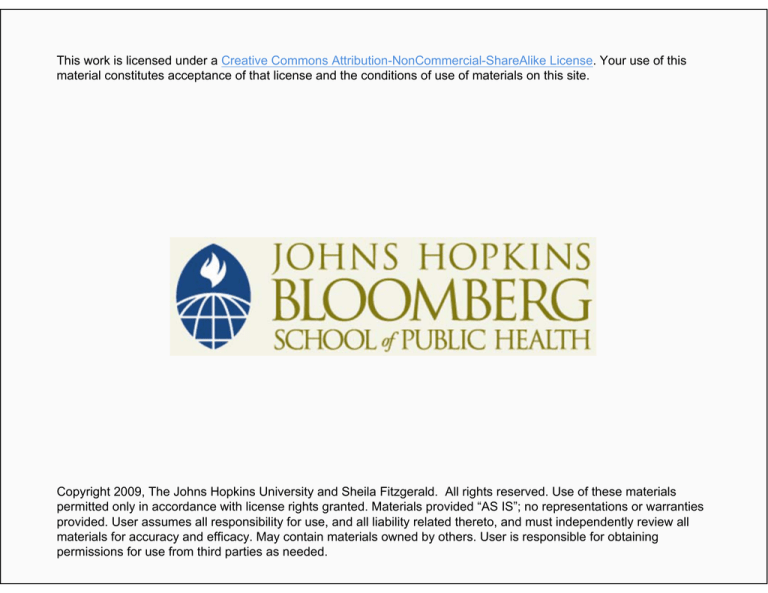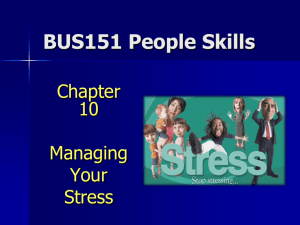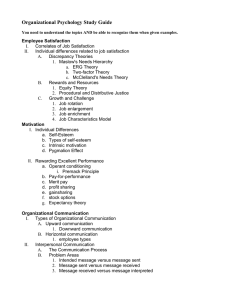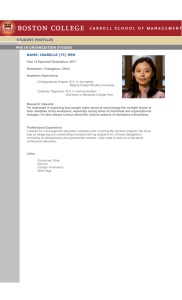
This work is licensed under a Creative Commons Attribution-NonCommercial-ShareAlike License. Your use of this
material constitutes acceptance of that license and the conditions of use of materials on this site.
Copyright 2009, The Johns Hopkins University and Sheila Fitzgerald. All rights reserved. Use of these materials
permitted only in accordance with license rights granted. Materials provided “AS IS”; no representations or warranties
provided. User assumes all responsibility for use, and all liability related thereto, and must independently review all
materials for accuracy and efficacy. May contain materials owned by others. User is responsible for obtaining
permissions for use from third parties as needed.
Women and Work
Sheila T. Fitzgerald, PhD, RN-P
Johns Hopkins University
Section A
Overview
Women and Work
Photo source: Dotter, Earl. (1998).
4
Women and Work
Photo source: Dotter, Earl. (1998).
5
Women and Work
Photo source: Dotter, Earl. (1998).
6
Women and Work
Photo source: Dotter, Earl. (1998).
7
Demographics
68 million
− 75% work full time
−
25% work part time
5.7% of women workers hold multiple jobs
Median earnings of women
−
−
62% of men in 1979
80% of men in 2007
Women ages 25–62: percentage with a college degree tripled
between 1970 and 2007
Source: Bureau of Labor Statistics. (2007).
8
Demographics
Asian and white women: 47% and 39%, respectively, worked in
management, professional, and related occupations
Black and Hispanic women: sales and office occupations—33%
Unemployment for women: 4.5% (for men it was 4.7% in 2007)
−
−
−
−
Asian women: 3.4%
White women: 4.0%
Hispanic women: 6.1%
Black women: 7.5%
9
Demographics
Minority workers (black and Hispanic): earnings of women more
comparable to men
50% of married women working; of never-married women, 67%
working
10
Weekly Earnings, by Sex (1979–2007)
11
Weekly Earnings, by Sex, Ethnicity (2007)
12
Change in Earnings, by Education Level and Sex
13
Distribution of Employment, by Sex and Occupation
14
Section B
Where Do Women Work?
Where Do Women
Work?Women
Where
Location
Work
Percent
Office
45
Health related
10
Education
Sales related
7
13
Home
1
Food
6
Factory, industrial
7
Construction
0
Transport
1
Agriculture
1
Hair/cosmetology
1
Other
6
Source: Based on 1997 BLS and Department of Labor statistics.
16
Work outside the Home: Demographics
Occupations (1997)
Total (16 years and over)
Employed
(in thousands)
59,873
Occupations (1997)
Employed
(in thousands)
Receptionists
970
Secretaries
2,989
Accountants and auditors
921
Cashiers
2,356
Machine operators, assorted
913
Managers
2,237
Cooks
888
Registered nurses
1,930
Textile and apparel
781
Sales supervisors
1,780
Janitors and cleaners
756
Nursing aides and orderlies
1,676
Investigators and adjustors
735
Bookkeepers, accounting
1,602
Administrative support
702
Elementary school teachers
1,571
Secondary school teachers
685
Waiters and waitresses
1,070
Hairdressers
676
Sales workers, other
1,014
Total top 20 occupations
Source: Based on 1997 BLS and Department of Labor statistics.
26,252
17
Workplace Health Worries
18
Where Do Women Work?
The Working Poor, Shipler (2004)
Nickel and Dimed, Ehrenreich (2001)
19
Where Do Women Work?
Hazardous sectors where women are employed
−
Hairdressing, electronics, health care, cosmetology, dry
cleaning, safety
20
Safety and Health Issues for Working Women
Musculoskeletal disorders
Job stress—Is it ubiquitous?
Violence in the workplace
21
Musculoskeletal Disorders
Overall, three times more women suffer from work-related muscular
disorders than men
Women have sedentary jobs with repetitive motion
Anthropometric differences—smaller carpal canal size
Hormone status—pregnancy
22
Exposures—Continued
Health care workers
− Medications
−
−
−
−
Biologic agents
Anesthetic gases
Latex
Violence
23
Exposures—Continued
Health care workers
− Medications
−
−
−
−
Biologic agents
Anesthetic gases
Latex
Violence
24
Misperceptions
False sense of safety
−
−
Few women employed in dangerous occupations—mining,
construction, logging, fishing
However, women accounted for half of lost-work-time non-fatal
injuries in 2003
25
Women in Non-traditional Employment
Problem with PPE—often designed for average-sized men
Total body strength—two-thirds of men, lower in upper extremities,
similar to men in lower extremities
Repetitive, forceful, and awkward motions associated with
musculoskeletal disorders
Social stressors—sexual harassment, gender-based discrimination
26
Issues in Construction (OSHA, 1999)
Workplace culture
− Isolation
−
−
Hostility
Sexual harassment—looks, gestures, joking
Sanitary facilities
Personal protective equipment
Ergonomics
27
Issues in Construction (OSHA, 1999)
Workplace culture
− Isolation
−
−
Hostility
Sexual harassment—looks, gestures, joking
Sanitary facilities
Personal protective equipment
Ergonomics
28
Additional Exposures
Endocrine disrupters or environmental estrogens—proposed risk
factors for breast cancer
Phthalates—plasticizers (IV bags, tubes, food wraps)
Dioxins—incineration of PVC
Pesticides, PCBs, organic solvents
29
Ergonomic Stressors
Ergonomic stressors (associated with spontaneous abortions)
− Heavy lifting
−
−
Heavy industrial cleaning
Long periods of standing
30
Violence in the Workplace
Homicide—lead cause of injury death for women in workplace
(accounts for 40% of all workplace deaths among female workers)
Primarily robbery-related and often occur in grocery/convenience
stores, eating and drinking establishments, and gasoline stations
25% of female victims are assaulted by people they know (co-worker,
customers, spouses, or friends)
Domestic violence—accounts for 16% of female victims of job-related
homicide
31
Workplace Violence
Source: Bureau of Labor Statistics. (2005). Survey of workplace violence prevention.
32
Workplace Violence
Source: Bureau of Labor Statistics. (2005). Survey of workplace violence prevention.
33
Workplace Violence
Source: Bureau of Labor Statistics. (2005). Survey of workplace violence prevention.
34
Prevention of Workplace Violence
Cash-handling policies
Physical separation of workers from customers, clients, and the
general public
Visibility and lighting
Access to and egress from the workplace
35
Impact of Urinary Incontinence on Working Women
Studies completed in academic setting and production facility
OSHA memorandum
Findings
−
−
−
−
Age and BMI
Women did not report to HCP
Reduced fluid intake
Wore pads to control urine loss
36
Female Adolescent Workers
Predominantly employed in retail and service sector
Emotional labor (EL)—the management of feeling to create a publicly
observable facial and bodily display (Hochschild, 1983)
EL sometimes entails interactions with angry, hostile, or
uncooperative customers
Increased work demand
37
Characteristics of EL
Face-to-face or voice contact with the public
Employee is required to produce an emotional state in another
person (i.e, client or customer)
Employers, through training and supervision, exercise a degree of
control over the emotional activities of employees
Common among retail and service jobs
38
Outcomes of Emotional Labor
Job stress
Burnout
Depression
Source: de Castro.(2002).
39
Definition of Stress
Psychological stress refers to a particular kind of relationship
between the person and environment … the stress relationship is one
in which demands tax or exceed the person’s resources (Lazarus,
1990)
40
Sources of Stress for Women
Working mothers
− Less sleep
−
−
Greater illness
Less leisure time
Balance work and family life
Sandwich generation
41






